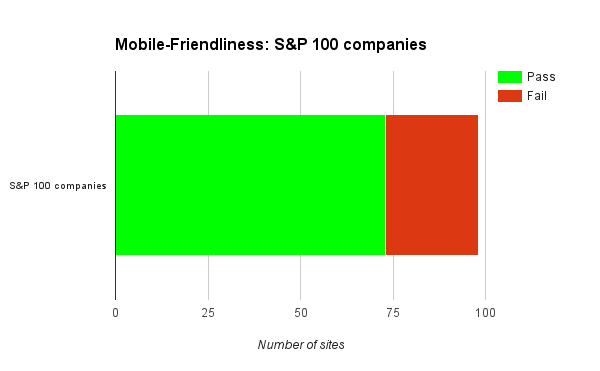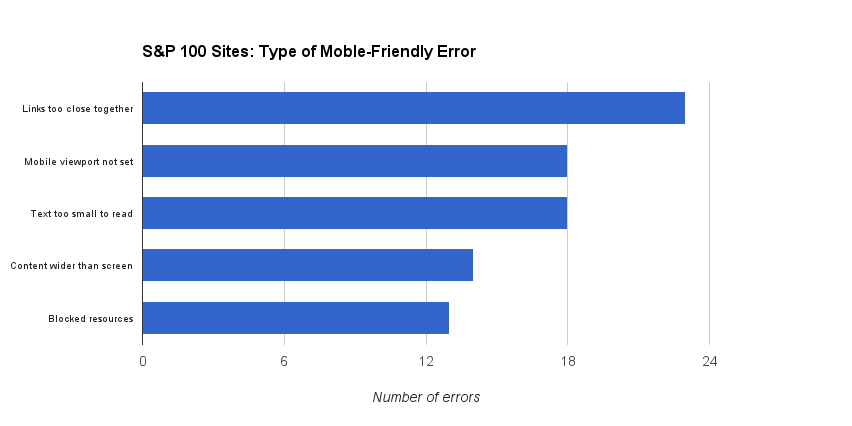April 17, 2015: To obtain a macro-level view of the possible impact of the forthcoming changes to Google’s Mobile Algorithm on Corporate America, Didit looked at sites maintained by large-cap S&P 100 sites. Here, we present a discussion of these findings, plus the raw data resulting from subjecting these sites to Google’s Mobile Friendly Test.
Background: on February 26th, 2015, Google announced that it would soon begin incorporating “mobile friendliness” as a ranking factor that will strongly influence the delivery of search results made on mobile devices, beginning 4/21/15. This date — popularly dubbed “mobilegeddon,” has caused widespread concern in the SEO/webmaster community and a flurry of corrective activity among site proprietors eager not preserve their rankings on mobile devices.
This study is the latest in our pre-4/21/15 series of evaluative surveys, which, to date, have included:
a) Major U.S. public relations Firms (published 4/2/15)
b) Large-cap companies on Long Island (published 4/6/15)
c) Major New York-based advertising agencies (published 4/9/15)
d) Major U.S. charities (published 4/14/2015)
e) Major “white shoe” law firms in the U.S. (published 4/15/15)
f) Big CPA/accountancy firms (published 4/15/15).
g) Top-rated NY-area hospitals (published 4/16/15).
Methodology
Didit ran each site URL through Google’s Mobile Friendly Test application page (https://www.google.com/webmasters/tools/mobile-friendly/) to see whether Google considers each site “mobile-friendly.” The specific error types causing any test failures were logged, and a screen capture was made of each report. Testing was begun and concluded on 3/26/2015. Only the main corporate sites were tested, not individual products, brands, or subsidiaries. So, for example, while Proctor & Gamble’s corporate site failed the test, its individual brands posted much higher (81 percent) pass rates.
Here is a summary of Didit’s findings:
1. 74 percent (73) of the 98 S&P 100 sites surveyed are fully “mobile-friendly” according to Google’s definition. (2 sites could not be tested by the tool).
2. The most common errors seen on the 25 sites failing Google’s Mobile Friendly test were:
a). Links spaced too closely together to be easily clicked on mobile devices. 23 sites had this error.
b) Mobile viewports not being set correctly. This error can cause the site to render in less than 100 percent of mobile display space. 18 failing S&P 100 sites had this error.
c) Text being set at a size too small to read on mobile devices. 18 failing sites had this error.
d) Content wider than screen. This error can cause the site to become arbitrarily “cropped” along the horizontal dimension when viewed on a mobile device. 14 failing sites had this error.
e.) Blocking of resources necessary for the Googlebot to correctly parse the resources referenced by the web page. 13 sites had this error.
Analysis
 Sites in the S&P 100 were expected to do very well on Google’s Mobile Friendly test, given that these companies have sufficient funds to maintain modern sites capable of rendering equally well on mobile and desktop devices. And this group’s pass rate of 74 percent was the highest seen in any group tested so far.
Sites in the S&P 100 were expected to do very well on Google’s Mobile Friendly test, given that these companies have sufficient funds to maintain modern sites capable of rendering equally well on mobile and desktop devices. And this group’s pass rate of 74 percent was the highest seen in any group tested so far.
Still, it’s clear that there’s room for improvement, and companies interested in not disappointing mobile users should make the needed changes in the next few days. Given the sizeable investment many of these companies have made in their web properties, it would seem reasonable that senior management would prefer that these sites render as well on mobile devices as they do on traditional large format desktop displays (i.e. be “mobile-friendly.”)
It’s important to note that the fact that a given S&P 100 site fails to pass Google’s Mobile Friendly Test does not mean that it will be invisible or inaccessible on mobile devices on or after 4/21/2015. But Google has clearly indicated that poor showings on this test may result in less visibility in search results made from mobile devices under certain circumstances. This is a growing concern as mobile traffic — and searches made on mobile devices — increase in importance. Marketing consultancy firm Emarketer.com recently reported that “2015 will see mobile search reach the tipping point — the stage at which the majority of spend, organic traffic, and paid clicks comes from smart phones and tablets.”
The good news for the S&P 100 is that in most cases the actual problems causing a “Fail” on Google’s Mobile Test can be quickly resolved — sometimes in under an hour. Because companies have only a few days to rectify these problems, senior management should take this issue seriously and make any corrections required in time for the 4/21/15 deadline.
- 10 Mistakes to Avoid When Using QR Codes for Marketing - September 20, 2023
- Kevin Lee on How AI Changes the SEO Landscape - August 31, 2023
- The Power of Compound Marketing: Kevin Lee Presents @ 1MediaWorld 2023 Global Conference - March 7, 2023



